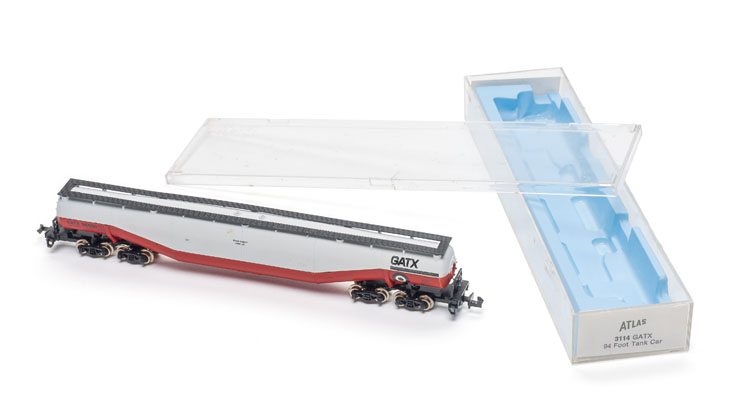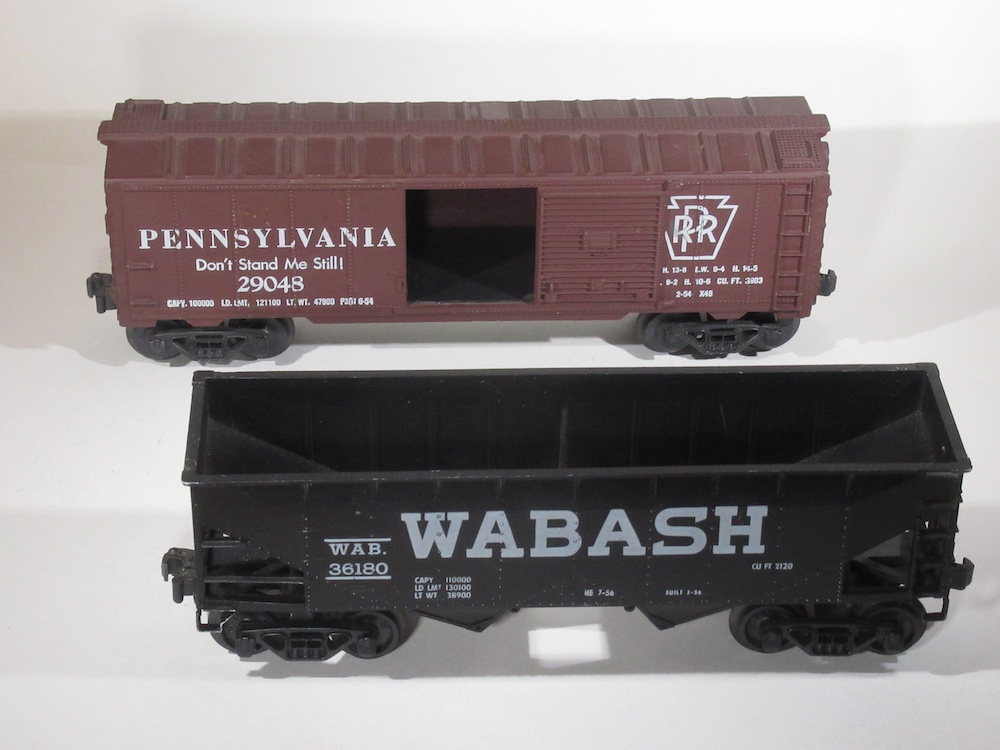The “they” in my unused title was Atlas, which had the N scale whale-belly tank car shown in the photo manufactured for them by Roco in Austria. I’d ask the folks at Atlas what they were thinking, but I doubt if anyone who was involved in product development in the late 1960s is still there. It seems impossible, but this model is almost 50 years old.

The car hit the dealer shelves in 1970. The suggested retail price was $4, which only seemed fair considering you got twice as long a body and twice as many wheels as the typical cars that usually went for about two bucks. Besides the model shown here, Atlas made one painted for Texaco, and another for Wanda Petroleum.
First off, at 97 feet long, the prototype was the longest freight car ever built. For the foreseeable future, it will remain so – in the 1970s the Federal Railroad Administration ruled freight cars could be no longer than 89 feet. (As a consequence, today flatcars and auto racks are that long and no longer.)
The whale-belly car had a capacity of just over 60,000 gallons. (The biggest tank cars we see in service nowadays hold about half that amount.) It was built by General American in 1965 and the production run was short – GATX 96500 was the only one General American ever built. It was designed to carry either anhydrous ammonia or liquid petroleum gas.
If you’d like to see the prototype, it’s beached at the Museum of Transportation in Kirkwood, Mo., just outside St. Louis. A similar car, UTLX 83699, was built by Union Tank Car in 1963, but it carried 10,000 fewer gallons.
What sort of modeler would buy such a thing? I don’t really know, but somehow I ended up with two of them, and I doubt someone slipped into my house and planted them there.
I don’t recall ever trying to run these cars, and I doubt they could’ve dealt with the 93⁄4″-radius curves on the 3 x 5-foot layout I had then. Just getting all 16 of those wheels on the rails at the same time would’ve been quite a challenge. Definitely you’d want to use the N-scaler’s best friend, a rerailer.
The way we were
Today, I believe a manufacturer would be quite hesitant to introduce such colossal models, even though today there are probably more large N scale layouts with broader curves that could accommodate them. And of course, in today’s railroading, longer cars and locomotives have become commonplace. My layout has 18″ minimum-radius curves and the big equipment would be happier if they were larger.
Fifty years ago model railroaders, regardless of scale, didn’t think prototype nearly as much as we do today. Today many manufacturers, including most of our N scale makers, bill their offerings as models of specific cars built by specific builders. They tell us when the cars were built, the railroads that bought them, and offer them in paint schemes that were actually out there on the rails.
Half a century ago this wasn’t the case – and it’s not entirely the case today – but in 1970 a manufacturer tended to offer, let’s say, 40-foot boxcars in single-door and double-door versions, the same for 50-foot boxcars, and they’d paint them with roadnames they knew would sell.
As the saying goes, you could slap a Santa Fe herald on anything and it would fly off the shelf. The models would probably actually have a prototype because the makers needed some kind of drawings to work from, but that fact wouldn’t be considered important enough to point out.
Another important point is that in those early days, we fledgling N-scalers were starved for product and would buy just about anything as soon as it came out.
Baffled as someone like me might be by the appearance of models that seem impractical and unmarketable, these cars were certainly distinctive and interesting, and for all I know, Atlas sold a jillion of them. I hope they did.
This article originally appeared in the January 2019 issue of Model Railroader – Ed.















Literally, every N Scale anything came out in Santa Fe back then. Times sure have changed from the Rapido couplers and pizza cutter wheels. The E Units and others with the nose pilot attached to the trucks for turn radius issues. The large openings for truck mounted couplers to turn. You didn’t need sound back then as everything made the grinding of a real locomotive.
Let’s not forget the Galveston Railroad Museum car that floated away……
http://www.railgoat.railfan.net/railwhales/bynumber/utlx083699.htm
Atlas actually produced four versions of the car with the fourth painted for Citgo. My father was instrumental in the development of that car, as well as the GATX TankTrain cars as chief engineer for General American. I remember seeing the prototype at the shops in Masury, Ohio when I was in grade school. It was probably the first tankcar model I bought when I entered N Scale in 1971. To date, I have amassed 33 of those in my collection, all converted to Micro-train trucks and couplers. It is becoming very difficult to locate an example that doesn’t have damaged running boards or end ladders and excellent condition ones have approached $100 at times. The prototype was surprisingly stable and tracked very well thanks to the bolster and span frame design. There were clearance concerns on the eastern roads and then of course, regulation set in on maximum capacities for LPG, but it was quite an engineering and manufacturing endeavor to achieve.